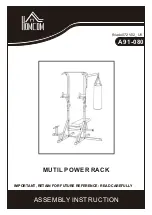
16
Safety Information
exceed the operating pressure of the weakest
component in the system.
Check Connections
Check the condition of the connection threads
prior to connecting fittings or hoses. Use anti-seize
compound on all fittings and hoses to prevent
“galling”, as galling will destroy the threads and
essentially the fittings and or connecting ends.
Never attempt to tighten fittings while under
pressure.
Tightening Connections
Properly tighten all high pressure connections.
Snug plus 15% will properly seal all UHP fittings.
Purge System
Before attaching spray bars to the Hog Head as-
sembly, engage the pump at low speed and close
the Dump Valve to force all water to the Through
Shaft to flush out any debris or foreign materials.
Any dirt or debris in the system can clog nozzle
orifices and cause system pressure to spike exces
-
sively, cause accelerated wear or cause immedi-
ate damage of the orifices. Damaged orifices will
cause reduced pressure and poor performance
and may in turn damage the substrate.
Test System
With the Spray Bar installed and all nozzles prop-
erly matched and tightened, operate the system
at low pressure to check for nozzle cohesivity and
or leaks on the Spray Bar or nozzle seats. Should
any repairs or adjustments be necessary, disen-
gage the UHP Pump to relieve all pressure before
making any required repairs or adjustments.
Set System Pressure
With the system operating properly, set your
pressure according to the methods described by
the pump
Use the Minimum Pressure Required
Do not exceed the operating pressure of the sys-
tem’s lowest pressure-rated component. All equip-
ment pressure rating and warning tags should be
left intact.
Be Prepared
If the equipment malfunctions or a malfunction
is suspected, immediately stop all blasting activ-
ity and relieve all pressure in the system before
attempting repairs. Always follow manufacturer’s
repair instructions. Only use thoroughly trained
personnel to perform maintenance or repairs.
Low Pressure Test
Following Repairs and upon starting a cold system,
operate the system at low pressure for a test.
Bring the equipment up to operating pressure
slowly.
Freezing Conditions
Because the system uses water for operations
it is susceptible to freeze damage which can be
debilitating and costly. Make sure you properly
protect your equipment during freezing tempera-
tures. Warm the hydraulic oil and components to
60o Fahrenheit (16o Celsius) before attempting
to achieve full operating pressure or operating
the equipment. Proper protection measures can
be found on the Stripe Hog Support site at www.
stripehogsupport.com under the training tab or by
calling the Customer Service Dept at (772) 223-
7393 and in the procedures section of this manual.
Do not take short-cuts they can be very costly.
Store Components Properly
Protect all components from damage during stor-
age and travel. For example, Spray Bars should
be stored with the nozzles pointed up and should
never be allowed to be turned nozzles down in
order to prevent the nozzles from getting contami-
nated with dirt which can cause premature wear.
Injection Risk
Any Fluid under pressure poses the risk of injection
injury to personnel. Injection wounds can be very
dangerous even when the fluid is clean. Injection
wounds must be treated immediately by a doctor
who is trained in dealing with these injuries. Never
check for leaks in hoses or connections with your
Hog Head
Summary of Contents for Stripe Hog SH5000
Page 1: ...Operations Manual...
Page 2: ...2...
Page 4: ...4 THIS PAGE WAS LEFT BLANK INTENTIONALLY...
Page 6: ...6 THIS PAGE WAS LEFT BLANK INTENTIONALLY...
Page 8: ...8 THIS PAGE WAS LEFT BLANK INTENTIONALLY...
Page 14: ...14 THIS PAGE WAS LEFT BLANK INTENTIONALLY...
Page 20: ...20 THIS PAGE WAS LEFT BLANK INTENTIONALLY...
Page 50: ...50 THIS PAGE WAS LEFT BLANK INTENTIONALLY...
Page 58: ...58 THIS PAGE WAS LEFT BLANK INTENTIONALLY...
Page 92: ...92 Component Repair THIS PAGE WAS LEFT BLANK INTENTIONALLY...
Page 94: ...94 Component Repair...
Page 96: ...96 Component Repair...
Page 98: ...98 Component Repair...
Page 99: ...99 Fluid End Replacement Parts Appendix A Drawings and Supplies...
Page 100: ...100 THIS PAGE WAS LEFT BLANK INTENTIONALLY...
Page 104: ...104 THIS PAGE WAS LEFT BLANK INTENTIONALLY...
Page 106: ...106 THIS PAGE WAS LEFT BLANK INTENTIONALLY...
Page 110: ...110 THIS PAGE WAS LEFT BLANK INTENTIONALLY...
Page 118: ...118 THIS PAGE WAS LEFT BLANK INTENTIONALLY...
Page 121: ......
















































